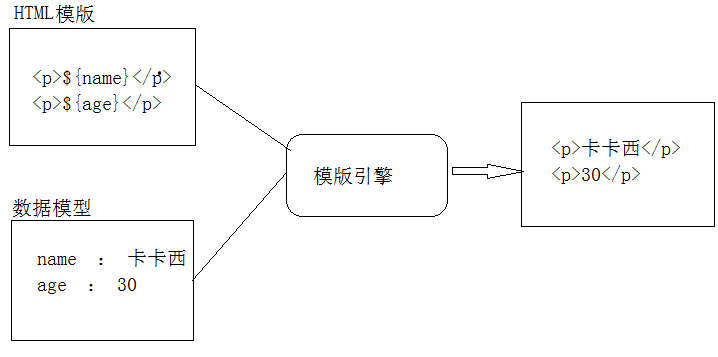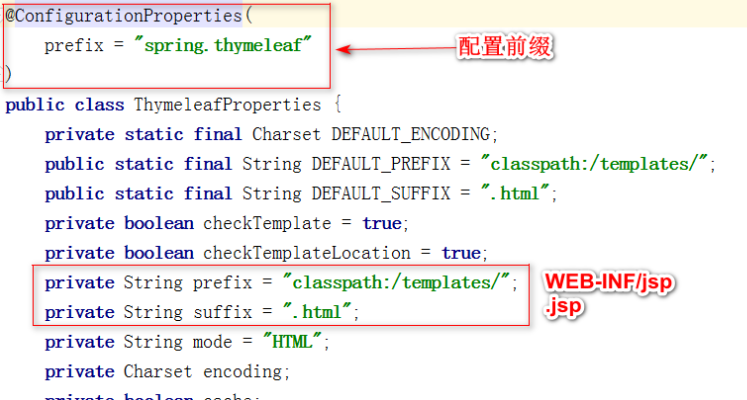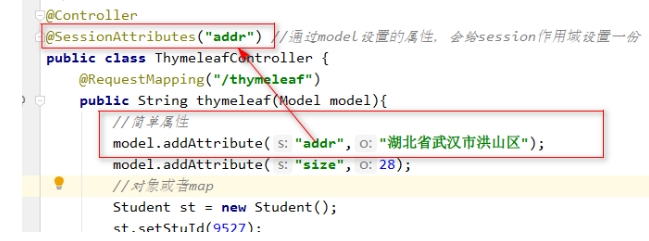一、介绍
springboot更建议使用Thymeleaf作为模板引擎
springboot本身就有一个Thymeleaf的启动器
<!--thymeleaf场景启动器 --><dependency><groupId>org.springframework.boot</groupId><artifactId>spring-boot-starter-thymeleaf</artifactId></dependency>
这是一个HTML模板引擎,类似于JSP
模板引擎:JSP,Thymeleaf,Freemarker….
模板引擎都是为了:用户界面和业务数据分离而产生,可以生成特定格式的文档,用于网站的模板引擎会生成一个标准的HTML文档
工作原理:(HTML模板)
SpringBoot对Thymeleaf的支持
【1】加入启动器
【2】springboot对thymeleaf的自动配置:
Thymeleaf自动配置类:自动配置类中添加Thymeleaf需要的所有Bean
属性绑定的类:
Thymeleaf模板默认放在classpath:/templates/下。后缀为.html。
也可以修改这个属性:
spring: thymeleaf: prefix: classpath:/tem/ suffix: .xml
Thymeleaf的语法
Thymeleaf中获取request作用域中的数据使用${key.attrtute}
【1】th:text和th:utext替换元素的文本内容
/**
* @author:Cherry
* @createTime:2021-03-30
*/
@Controller
public class ThymeleafController {
@RequestMapping("/thy")
public String thymeleaf(Model model){
//简单属性
model.addAttribute("addr","湖北省武汉市洪山区");
model.addAttribute("size",28);
//对象或者map
Student student = new Student();
student.setStuId(9527);
student.setStuName("小樱");
model.addAttribute("st",student);
return "thymeleaf";
}
}
<!DOCTYPE html>
<html lang="en" xmlns:th="http://www.thymeleaf.org">
<head>
<meta charset="UTF-8">
<title>$Title$</title>
</head>
<body>
<ul>
<li>简单属性:</li>
<!-- 使用th:text替换文本的内容 -->
<li th:text="${addr}">123456</li>
<li th:abbr="${size}">123</li>
<li>对象属性:</li>
<li th:text="${st.stuId}">nfjsfs</li>
<li th:text="${st.stuName}">hgjdas</li>
</ul>
</body>
</html>
说明:
controller的操作就是将数据放入request作用域中。
th:text属性说明:可以写在任何有内容的标签中。
-th:text=”表达式” ,表达式的内容会覆盖标签内部的文本。
-表达式就类似于EL表达式可以从request域中获取数据。
th:text和th:utext有什么区别
在request域中添加一个标签
model.addAttribute(“msg”,”
欢迎您!小丸子!
“)
html页面获取
最后界面
总结:th:text不解释运行html代码,纯文本输出
th:utext解释运行html代码
【2】简单的表达式
Literals
- 文本:
'one text','Another one!',… - 数字:
0,34,3.0,12.3,… - 布尔值:
true,false - Null:
null - Literal tokens:
one,sometext,main,…
Text operations:
- String concatenation:
+ - Literal substitutions:
|The name is ${name}|
Arithmetic operations:
- Binary operators:
+,-,*,/,% - Minus sign (unary operator):
-
Boolean operations:
- Binary operators:
and,or - Boolean negation (unary operator):
!,not
Comparisons and equality:
- Comparators:
>,<,>=,<=(gt,lt,ge,le) - Equality operators:
==,!=(eq,ne)<ul> <li>简单属性:</li> <!-- th:text:替换标签的文本内容 --> <li th:text="${addr}">123123</li> <li th:abbr="${size}">2342</li> <li>对象的属性值:</li> <li th:text="${st.stuId}">sdfsdf</li> <li th:text="${st.stuName}">werwer</li> </ul> <ul> <li th:text="${msg}"></li> <li th:utext="${msg}"></li> </ul> <h2>简单的表达式</h2> <ul> <li>普通的字符串:<span th:text="今天中午吃点啥">abc</span></li> <li>数字:<span th:text="9527"></span></li> <li>布尔值 : <span th:text="false"></span></li> <li>null:<span th:text="null"></span></li> <li><span th:text="abc,def,h"></span></li> </ul> <ul> <li>常见的运算符的运算</li> <li>size: <span th:text="${size + 10}"></span></li> <li>逻辑运算: <span th:text="${st.stuId == 9527 && size > 20}"></span></li> <li>字符串连接: <span th:text="${'姓名->'+st.stuName}"></span></li> <li>三元运算符: <span th:text="${size> 20 ?'OK':'no'}"></span></li> </ul>
【3】控制流程语句
if语句
<!-- if表达式的结果为true就显示 -->
<p th:if="${表达式}">内容</p>
案例**
准备数据:model.addAttrbute("admin",false);
页面获取:
- 是管理员
- 不是管理员
遍历集合
语法:th:each="prod :${prods}" ``//prod就是每一个对象,prods就是遍历的目标集合
案例
准备数据
//准备一个集合
List<Student> sts = new ArrayList<>();
for(int i = 0;i<10;i++){
Student s = new Student();
s.setStuId(i+1);
s.setStuName("鸣人"+s.getStuId());
sts.add(s);
}
model.addAttribute("sts",sts);
页面获取数据
<table align="center" width="500" border="1" cellspacing="0">
<tr>
<th>编号</th>
<th>姓名</th>
</tr>
<tr th:each="st : ${sts}">
<td th:text="${st.stuId}"></td>
<td th:text="${st.stuName}"></td>
</tr>
</table>
迭代的时候可以设置一个循环变量对象
<!-- th:each是写在要迭代的标签中的 -->
<table align="center" width="500" border="1" cellspacing="0">
<tr>
<th>序号</th>
<th>编号</th>
<th>姓名</th>
</tr>
<tr th:each="st,stStat : ${sts}" th:class="${stStat.odd}?'tr_color'">
<td th:text="${stStat.index}"></td>
<td th:text="${st.stuId}"></td>
<td th:text="${st.stuName}"></td>
</tr>
</table>
stStat就是循环变量对象,这个对象有属性index,从0开始,也有属性count从1开始。
属性odd,布尔类型,表示是否是偶数行。
注:stState不是特定的名字,只要在st后面使用”,”就可以添加。
【4】超链接和onclick写法
数据的列表一般都查看编辑删除等超链接,并且是动态生成的。
<th>
<a th:href="@{inputEdit(stuId=${st.stuId},stuName=${st.stuName})}"
href="inputEdit?stuId=${st.stuId}">编辑</a>
<a th:href="@{'javascript:deleteStu('+${st.stuId}+')'}" href="">编辑</a>
<a th:href="@{'stuDetail?stuId='+${st.stuId}}">查看详情</a>
</th>
【5】设置标签属性
Thymeleaf的语法是: th:xxxx
-这里的xxx就是属性名字。 前面说过的th:text。
th:href=”” 这个属性会自动替换标签中原有的href属性。
th:class=”” 会自动替换原有的class属性。
【6】Thymeleaf的内置对象
web相关的内置对象:
#ctx: the context object.#vars:the context variables.#locale: the context locale.#request: (only in Web Contexts) theHttpServletRequestobject.#response: (only in Web Contexts) theHttpServletResponseobject.#session: (only in Web Contexts) theHttpSessionobject.#servletContext: (only in Web Contexts) theServletContextobject.
以上内置对象和之前的内置对象,异曲同工。
案例:在页面使用#session取出session中的数据。
在Controller中给session添加一个数据:
- 取出session中的数据:
案例:
1.日期model.addAttribute("now",new Date());
页面:
日期:
2.字符串函数(java中String类的函数基本都有)model.addAttribute("testStr","在上下文变量上计算OGNL表达式时");
页面:
3.list函数
List<User> users = new ArrayList<User>();
for(int i = 0;i<10;i++){
users.add(new User(i,"鸣人"+i,18));
}
model.addAttribute("users",users);
页面:
th:object属性
之前:
<ul th:object="${user}">
<li th:text="*{id}"></li>
<li th:text="*{name}"></li>
<li th:text="*{age}"></li>
</ul>

